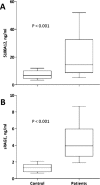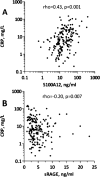Effect of circulating soluble receptor for advanced glycation end products (sRAGE) and the proinflammatory RAGE ligand (EN-RAGE, S100A12) on mortality in hemodialysis patients
- PMID: 20847094
- PMCID: PMC2994082
- DOI: 10.2215/CJN.03360410
Effect of circulating soluble receptor for advanced glycation end products (sRAGE) and the proinflammatory RAGE ligand (EN-RAGE, S100A12) on mortality in hemodialysis patients
Abstract
Background and objectives: The soluble receptor of advanced glycation end products (sRAGE) may exert anti-inflammatory protective roles on the vasculature. In contrast, the RAGE ligand S100A12 (also known as EN-RAGE) contributes to inflammation and the development of atherosclerosis in animal models. Whether alterations at this level contribute to the increased mortality observed in patients on dialysis is currently unknown.
Design, setting, participants, & measurements: Prospective study including 184 prevalent hemodialysis patients and 50 healthy controls matched for age and gender. Plasma concentrations of S100A12 and sRAGE were studied in relation to risk profile and mortality after a median follow-up period of 41 months.
Results: S100A12 and sRAGE levels were significantly elevated in hemodialysis patients compared with healthy controls. S100A12 had a strong positive correlation with C-reactive protein and IL-6, whereas sRAGE negatively associated with C-reactive protein. S100A12, but not sRAGE, was independently and positively associated with clinical cardiovascular disease (CVD). During follow-up, 85 (33 cardiovascular-related) deaths occurred. Whereas sRAGE did not predict mortality, S100A12 was associated with both all-cause (per log(10) ng/ml hazard ratio [HR] 1.93, 95% confidence interval [CI] 1.18 to 3.15) and CVD-related (HR 3.23, 95% CI 1.48 to 7.01) mortality, even after adjustment for age, sex, vintage, and comorbidities. Further adjustment for inflammation made the predictive value of S100A12 disappear for all-cause mortality, but still persisted in CVD-related mortality.
Conclusions: Circulating S100A12 and sRAGE are both elevated in hemodialysis patients. However, only S100A12 associates with mortality, partly explained by its links with inflammation.
Figures
Similar articles
-
Plasma S100A12 and soluble receptor of advanced glycation end product levels and mortality in chronic kidney disease Stage 5 patients.Nephrol Dial Transplant. 2015 Jan;30(1):84-91. doi: 10.1093/ndt/gfu259. Epub 2014 Jul 28. Nephrol Dial Transplant. 2015. PMID: 25074436 Clinical Trial.
-
Associations between Soluble Receptor for Advanced Glycation End Products (sRAGE) and S100A12 (EN-RAGE) with Mortality in Long-term Hemodialysis Patients.J Korean Med Sci. 2017 Jan;32(1):54-59. doi: 10.3346/jkms.2017.32.1.54. J Korean Med Sci. 2017. PMID: 27914132 Free PMC article.
-
Circulating soluble receptor for advanced glycation end products is inversely associated with glycemic control and S100A12 protein.J Clin Endocrinol Metab. 2006 Nov;91(11):4628-34. doi: 10.1210/jc.2005-2559. Epub 2006 Aug 22. J Clin Endocrinol Metab. 2006. PMID: 16926247
-
Soluble receptor for advanced glycation end products: from disease marker to potential therapeutic target.Curr Med Chem. 2006;13(17):1971-8. doi: 10.2174/092986706777585013. Curr Med Chem. 2006. PMID: 16842191 Review.
-
Therapeutic Interventions for Advanced Glycation-End Products and its Receptor- Mediated Cardiovascular Disease.Curr Pharm Des. 2017;23(6):937-943. doi: 10.2174/1381612822666161006143032. Curr Pharm Des. 2017. PMID: 27719648 Review.
Cited by
-
Effects of Short- And Medium-Term Exposures to Lower Air Temperature on 71 Novel Biomarkers of Subclinical Inflammation: Results from the KORA F4 Study.Environ Sci Technol. 2023 Aug 22;57(33):12210-12221. doi: 10.1021/acs.est.3c00302. Epub 2023 Aug 8. Environ Sci Technol. 2023. PMID: 37552838 Free PMC article.
-
Advanced glycation end product accumulation: a new enemy to target in chronic kidney disease?Curr Opin Nephrol Hypertens. 2014 Nov;23(6):547-54. doi: 10.1097/MNH.0000000000000062. Curr Opin Nephrol Hypertens. 2014. PMID: 25160075 Free PMC article. Review.
-
S100A12 and the S100/Calgranulins: Emerging Biomarkers for Atherosclerosis and Possibly Therapeutic Targets.Arterioscler Thromb Vasc Biol. 2015 Dec;35(12):2496-507. doi: 10.1161/ATVBAHA.115.302072. Epub 2015 Oct 29. Arterioscler Thromb Vasc Biol. 2015. PMID: 26515415 Free PMC article. Review.
-
The use of the soluble receptor for advanced glycation-end products (sRAGE) as a potential biomarker of disease risk and adverse outcomes.Redox Biol. 2021 Jun;42:101958. doi: 10.1016/j.redox.2021.101958. Epub 2021 Mar 29. Redox Biol. 2021. PMID: 33839083 Free PMC article. Review.
-
Placental growth factor, pregnancy-associated plasma protein-A, soluble receptor for advanced glycation end products, extracellular newly identified receptor for receptor for advanced glycation end products binding protein and high mobility group box 1 levels in patients with acute kidney injury: a cross sectional study.BMC Nephrol. 2013 Nov 4;14:245. doi: 10.1186/1471-2369-14-245. BMC Nephrol. 2013. PMID: 24188108 Free PMC article.
References
-
- Thornalley P: Advanced glycation end products in renal failure. J Ren Nutr 16: 178–184, 2006 - PubMed
-
- Thomas M, Tsalamandris C, MacIsaac R, Medley T, Kingwell B, Cooper M, Jerums G: Low-molecular-weight AGEs are associated with GFR and anemia in patients with type 2 diabetes. Kidney Int 66: 1167–1172, 2004 - PubMed
-
- Yamagishi S, Yonekura H, Yamamoto Y, Katsuno K, Sato F, Mita I, Ooka H, Satozawa N, Kawakami T, Nomura M, Yamamoto H: Advanced glycation end products-driven angiogenesis in vitro. Induction of the growth and tube formation of human microvascular endothelial cells through autocrine vascular endothelial growth factor. J Biol Chem 272: 8723–8730, 1997 - PubMed
-
- Rodríguez-Ayala E, Anderstam B, Suliman M, Seeberger A, Heimbürger O, Lindholm B, Stenvinkel P: Enhanced RAGE-mediated NFkappaB stimulation in inflamed hemodialysis patients. Atherosclerosis 180: 333–340, 2005 - PubMed
Publication types
MeSH terms
Substances
LinkOut - more resources
Full Text Sources
Medical
Research Materials
Miscellaneous



